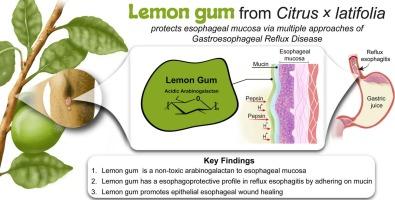在胃食管反流病实验模型中,柠檬胶包覆食管黏膜,促进其治疗作用:掌握预防和治疗
IF 12.5
1区 化学
Q1 CHEMISTRY, APPLIED
引用次数: 0
摘要
本研究评估了柠檬胶(LG)在胃食管反流病(GERD)实验模型中的治疗潜力,柠檬胶是一种来自柑橘渗出物的阿拉伯半乳聚糖生物聚合物。结构分析证实LG是一个复杂的,高支链酸性阿拉伯半乳聚糖。在大鼠反流性食管炎中,LG改善食管形态,减少白细胞浸润(多形核细胞和肥大细胞),减少细胞间隙扩张。小鼠食管样本的生化分析显示,LG降低了炎症和氧化应激标志物。组织学显示糜烂减少,组织保存较好。利用互补的生物物理技术,即石英晶体微天平与耗散监测(QCM-D)和原子力显微镜(AFM),在体外证明了lg -粘蛋白的结合;通过接触角测量来评估表面润湿性。在人食管活检中,免疫荧光分析显示了LG作为保护性表面涂层的黏附潜力。在培养的人食管上皮细胞中,LG没有表现出细胞毒性,并促进伤口愈合,正如划痕实验所证明的那样。总的来说,LG有助于食管保护,减轻反流性食管炎的特征,与粘蛋白相互作用,并支持上皮修复,这表明它有可能成为一种功能性生物材料,用于胃食管反流相关疾病的治疗。本文章由计算机程序翻译,如有差异,请以英文原文为准。

Lemon gum blankets esophageal mucosa and promotes therapeutic effects in experimental models of gastroesophageal reflux disease: Grasps for prevention and treatment
This study evaluated the therapeutic potential of lemon gum (LG), an arabinogalactan biopolymer from Citrus × latifolia exudate, in experimental models of gastroesophageal reflux disease (GERD). Structural analyses confirmed LG as a complex, highly branched acidic arabinogalactan. In reflux esophagitis in rats, LG improved esophageal morphology, reduced leukocyte infiltration (polymorphonuclear and mast cells), and decreased dilated intercellular spaces. Biochemical analysis in murine esophageal samples revealed that LG lowered inflammatory and oxidative stress markers. Histology showed reduced erosion and better tissue preservation. LG-mucin binding was evidenced in vitro using complementary biophysical techniques, namely quartz crystal microbalance with dissipation monitoring (QCM-D) and atomic force microscopy (AFM); and surface wettability was assessed through contact angle measurements. In human esophageal biopsies, immunofluorescence analysis revealed the mucoadhesive potential of LG as a protective surface coating. In cultured human esophageal epithelial cells, LG exhibited no cytotoxicity and promoted wound healing, as demonstrated by a scratch assay. Overall, LG contributes to esophageal protection, attenuates features of reflux esophagitis, interacts with mucins, and supports epithelial repair, suggesting its potential as a functional biomaterial for the management of gastroesophageal reflux-related conditions.
求助全文
通过发布文献求助,成功后即可免费获取论文全文。
去求助
来源期刊

Carbohydrate Polymers
化学-高分子科学
CiteScore
22.40
自引率
8.00%
发文量
1286
审稿时长
47 days
期刊介绍:
Carbohydrate Polymers stands as a prominent journal in the glycoscience field, dedicated to exploring and harnessing the potential of polysaccharides with applications spanning bioenergy, bioplastics, biomaterials, biorefining, chemistry, drug delivery, food, health, nanotechnology, packaging, paper, pharmaceuticals, medicine, oil recovery, textiles, tissue engineering, wood, and various aspects of glycoscience.
The journal emphasizes the central role of well-characterized carbohydrate polymers, highlighting their significance as the primary focus rather than a peripheral topic. Each paper must prominently feature at least one named carbohydrate polymer, evident in both citation and title, with a commitment to innovative research that advances scientific knowledge.
 求助内容:
求助内容: 应助结果提醒方式:
应助结果提醒方式:


